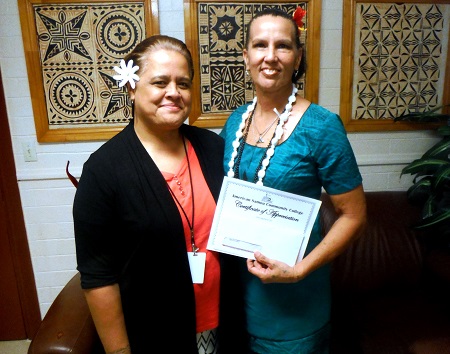
Artist Regina Meredith-Fitiao (right) of the ASCC Fine Arts Department is seen here with the College’s President Dr. Rosevonne Makaiwi Pato. Meredith recently wrote an article on the dyes used for Samoan siapo, which has been published in Turkey Red Journal, an online resource for practitioners all over the world who work with making dyes and applying them. (Photo: J. Kneubuhl)

Artist Regina Meredith-Fitiao (right) of the ASCC Fine Arts Department is seen here with the College’s President Dr. Rosevonne Makaiwi Pato. Meredith recently wrote an article on the dyes used for Samoan siapo, which has been published in Turkey Red Journal, an online resource for practitioners all over the world who work with making dyes and applying them. (Photo: J. Kneubuhl)
ASCC Artists Shares Samoan Dye Methods with Practitioners Worldwide
November 27, 2017
By James Kneubuhl, ASCC Press Officer
Probably few outside the art world have heard of the online publication Turkey Red Journal, but for those who practice the age-old craft of making natural dyes and applying them, the journal represents a valuable forum for sharing ideas. In fact, the publication has a global reach that’s wide enough that it currently features an article by artist Regina Meredith-Fitiao of the Fine Arts Department at the American Samoa Community College (ASCC). Meredith-Fitiao’s piece titled “Dyes for Samoan Siapo with a focus on ‘O’a” appears in the Fall 2017 edition, accessible online at http://turkeyredjournal.com/fitiao.html.
The article describes in great detail the process by which local artists transform bark scrapings from the ‘O’a tree into the brown dye of the same name. Meredith-Fitiao emphasizes the care for the environment which goes into the bark collection, such as rubbing soil into the area of the tree which has been scraped in order to aid the tree’s own recovery process. She then discusses the method for extracting the rich brown dye from the bark scrapings, and concludes with the procedure for applying the ‘O’a dye to the u’a (paper mulberry) cloth which serves as the “canvas” for the siapo. Meredith-Fitiao also notes how most of this information has come directly from her late mentors, siapo masters Mary Pritchard and her daughters Marylyn Pritchard Walker and Adeline Pritchard Jones.
In her introductory notes to the current edition, Turkey Red Journal editor and publisher Pamela Feldman explains how the connection with Meredith-Fitiao was forged when Feldman’s son Tristan visited American Samoa earlier this year as part of the Sea Education Association and relayed back to his mother word of the siapo artwork being done in the Territory. In addition to the artistic aspects of Samoan siapo, Feldman appreciated the nature-friendly approach of the indigenous-rooted process. “It is our intent to help dyers worldwide to communicate and share ideas about natural dyes and dye processes, and to promote the use of natural dyes in a manner that does not harm the environment or endanger personal safety,” said Feldman in her introduction.
The Turkey Red Journal was started in the spring of 1995, in Chicago, Illinois, after a number of local dyers formed a natural dye study group. The focus was to create a venue for natural dyers from all over the world to be able to share ideas and information. Since that time, 30 issues have been printed, sent out to over a hundred and twenty subscribers, with artists all over the world sharing their work and knowledge with the readers.
Editor and publisher Feldman teach classes in natural dyes and weaving for adults at the Chicago Botanic Gardens, Highland Park, IL, and this year she was invited to teach the Natural Dye class at the School of the Art Institute of Chicago. “Creating color from natural dyes comes from the need to understand the multiplicity of color in plants,” Feldman reflected. “Plants have a hidden beauty in the colors that they can produce, which is rarely obvious to the eye.”
For more information on Art classes at the College, see the ASCC catalog, which is available online at: www.amsamoa.edu.
